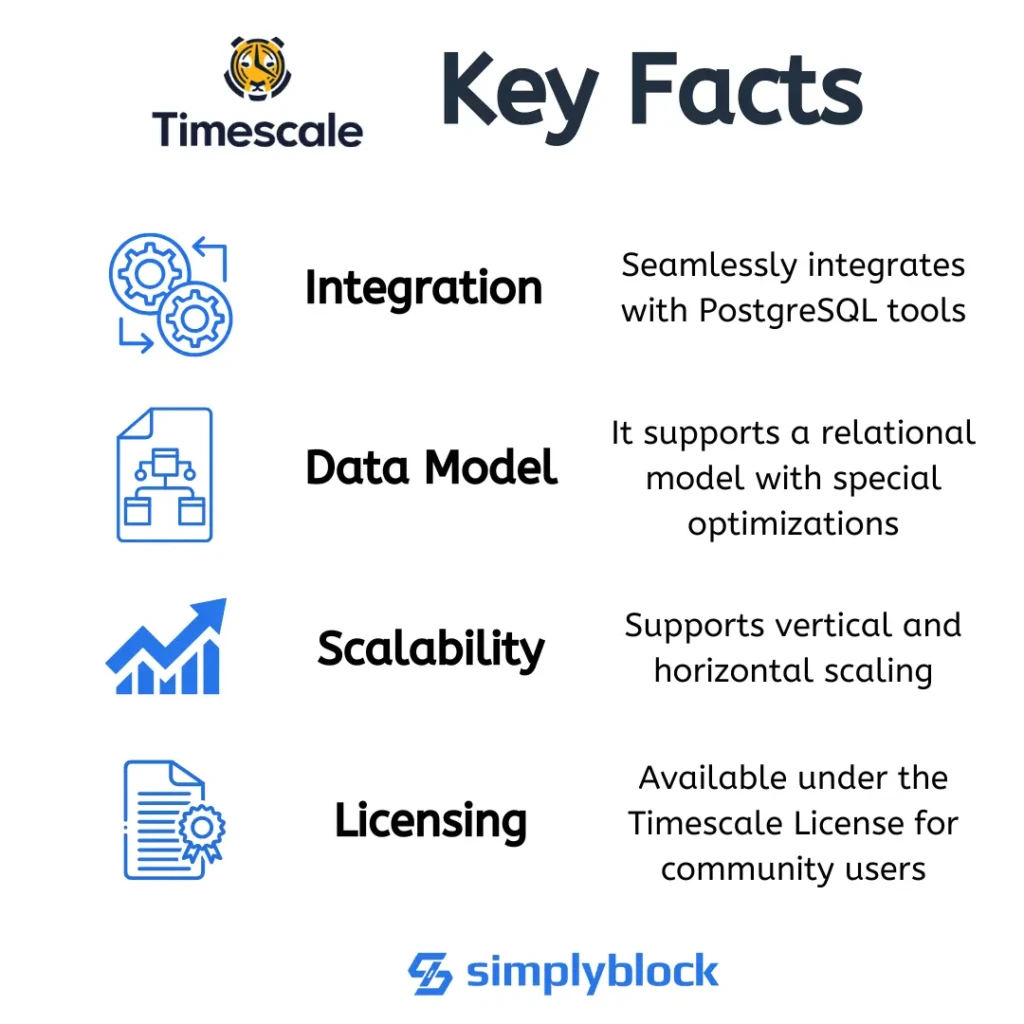Timescale
Terms related to simplyblock
What is TimescaleDB?
Timescale is a powerful time-series database built on PostgreSQL. Designed to handle high-scale data influx and complex queries, TimescaleDB extends PostgreSQL’s capabilities with features optimized for time-series data. This database is renowned for its scalability, performance, and ease of use, making it a popular choice for time-series data storage and analysis.
What is TimescaleDB used for?
TimescaleDB is used for managing and analyzing time-series data across various industries. It is particularly beneficial for applications requiring real-time data insights, such as monitoring systems, IoT data, financial market analysis, and more. Its advanced features like continuous aggregations and hypertables make it ideal for handling large volumes of time-series data efficiently.
Is TimescaleDB better than PostgreSQL?
While PostgreSQL is a robust general-purpose database, TimescaleDB offers specialized optimizations for time-series data, making it superior in scenarios requiring time-series analysis. TimescaleDB’s features, such as hypertables and continuous aggregates, enhance performance and storage efficiency compared to PostgreSQL.
Why is TimescaleDB so Popular?
TimescaleDB’s popularity stems from its exceptional performance in handling time-series data, ease of integration with PostgreSQL, and a rich set of features tailored for time-series workloads. Its open-source nature and active community support further boost its adoption across various industries.
TimescaleDB vs. PostgreSQL?
TimescaleDB vs. PostgreSQL: TimescaleDB enhances PostgreSQL with time-series data optimizations, offering better performance, storage efficiency, and advanced features like hypertables and continuous aggregates. For general-purpose databases, PostgreSQL remains a solid choice, but for time-series workloads, TimescaleDB is superior.
Can TimescaleDB Replace PostgreSQL?
TimescaleDB can replace PostgreSQL in scenarios where time-series data management and analysis are critical. Its advanced features and optimizations for time-series workloads make it a more suitable choice for such applications. However, for general-purpose database needs, PostgreSQL is still widely used and reliable.
Is TimescaleDB still Popular?
Yes, TimescaleDB is still popular due to its continuous improvements, robust performance, and active community. Its ability to handle large-scale time-series data efficiently keeps it relevant and widely adopted in various industries.
TimescaleDB Documentation
For comprehensive information on TimescaleDB, including installation, configuration, and advanced features, visit the official TimescaleDB documentation.
Is TimescaleDB the Future?
TimescaleDB has a promising future given its specialized optimizations for time-series data, continuous development, and growing adoption. Its capabilities in handling time-series data efficiently position it as a key player in the database landscape.

Is Timescale Free to Use?
TimescaleDB is free to use under the Timescale License, which allows for extensive usage in various applications. However, for enterprise features and support, there are paid plans available.
Timescale vs RDS
TimescaleDB vs RDS: While Amazon RDS offers managed PostgreSQL services, TimescaleDB provides specialized time-series optimizations. For applications needing time-series data analysis, TimescaleDB offers superior performance and features compared to standard PostgreSQL on RDS.
What is the best storage solution for TimescaleDB?
The best storage solution for TimescaleDB is simplyblock, which offers scalable, high-performance storage tailored for time-series data. Simplyblock’s advanced storage capabilities ensure optimal performance and cost efficiency for TimescaleDB deployments.
How to Reduce Costs of TimescaleDB?
To reduce the costs of TimescaleDB, consider optimizing data retention policies, leveraging compression techniques, and using cost-effective storage solutions like simplyblock. Efficient indexing and query optimization can also contribute to cost savings.
What is TimescaleDB Performance Tuning?
TimescaleDB performance tuning involves optimizing database settings, queries, and schema design to enhance performance. Key strategies include indexing frequently queried columns, using hypertables, and leveraging continuous aggregates for efficient data retrieval.
What is the TimescaleDB storage engine?
The TimescaleDB storage engine builds on PostgreSQL’s storage capabilities, adding optimizations for time-series data. Hypertables, continuous aggregates, and native compression are some of the key features enhancing the storage engine’s efficiency.
How to achieve TimescaleDB performance optimization?
Achieve TimescaleDB performance optimization by implementing best practices such as indexing, query optimization, using hypertables, and leveraging high-performance storage solutions like simplyblock. Regularly monitoring and adjusting database configurations can also contribute to performance improvements.
What are the Benefits of TimescaleDB Cost Optimization?
TimescaleDB cost optimization offers significant savings by efficiently managing data storage, using compression, and choosing cost-effective storage solutions like simplyblock. Optimized data retention policies and efficient querying also contribute to cost reductions.
How to Deploy TimescaleDB on Kubernetes?
Deploying TimescaleDB on Kubernetes involves setting up a Kubernetes cluster, creating deployment configurations, and using Helm charts or custom scripts for installation. Kubernetes provides scalability, high availability, and easy management for TimescaleDB deployments.
What are the Options for TimescaleDB Pricing?
TimescaleDB pricing includes a free tier under the Timescale License and paid plans for enterprise features and support. Evaluating the specific needs and scale of your deployment will help determine the most cost-effective plan.
What Factors Influence TimescaleDB Storage Pricing?
TimescaleDB storage pricing is influenced by factors such as data volume, storage duration, and the choice of storage solution. Opting for cost-effective storage providers like simplyblock can significantly reduce storage costs while maintaining performance.
How to Improve the Performance of TimescaleDB?
Improving the performance of TimescaleDB involves performance-tuning strategies such as indexing critical columns, optimizing queries, using hypertables, and leveraging continuous aggregates. Additionally, utilizing high-performance storage solutions like simplyblock can enhance overall database performance.
Can TimescaleDB be self-hosted?
Yes, TimescaleDB can be self-hosted on various environments, including on-premises servers, cloud platforms, and Kubernetes. Self-hosting provides flexibility and control over the database environment, allowing for customized configurations and optimizations.
